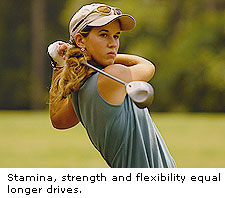Revealing the golf fitness secrets of touring professionals
Many of the top touring professionals know that winning on the tour today takes much more than a great game of golf. It means understanding every aspect of their physical and mental being and what factors influence their performance.
Before any golfer — pro or otherwise — picks up a club, they look at the capability of their body versus the requirements of the swing.
What exactly does this mean?
Most of us are aware that golf requires rotation at the hip joints, shoulder joints and spine. So, what if a golfer has a very tight low back or any restrictions in their shoulders? Well, the obvious answer is that any loss of range of motion creates swing flaws in addition to injuries.
This is a fact based on human performance and movement. It’s also necessary to create a fluid and natural golf swing. Not only does golf require good rotation at each joint, but it must be efficient and explosive.

Several years ago I had the opportunity to visit a human-performance center where some of the more famous tour players train. I was able to explore the same tests they take as part of their initial assessment period. Remember since we are all built differently and have different strengths and weaknesses, we all test differently.
The results of these tests help guide, direct and prioritize any training program moving forward. How successful is this approach to golf conditioning? I watched it place a green jacket on a well-deserving young player just a couple of years ago.
What exactly do you test for?
- Muscle strength. Evaluate each significant muscle group. Are there any significant differences between your left side and your right side?
- Range of Motion. Do you have adequate range of motion in the joints which most affect the golf swing? How does your lower body look versus your upper body? Does your left side match the flexibility in your right?
- Core strength and endurance. Do you know how to properly engage your core region? If so, for how long?
- Aerobic capacity and endurance. Do you have what it takes to last through a solid 18 holes? Is there an opportunity for improvement?
- Balance. Do you have proper balance? Do you know what normal balance for golf looks like?
Physical assessment tests are commonly used by the top touring pros today. These tests are being offered at some of the top golf performance centers and will surely be the wave of the future. It’s your true understanding of your relative strengths and weaknesses that creates opportunities for immediate and sound improvement in your game.
Take the following tests to sample how well you would do under the same criteria.
How strong is your core?
- Lie on your back with your knees bent.
- Place one hand underneath your lower back, then extend your knees to 90 degrees.
- Press the lower back firmly against your hand.
- Slowly lower your feet towards the ground by keeping the same tension on your hand.
Which one of the following best describes what happened when you performed the exercises above:
(A) Your lower back lifted and you could no longer feel any pressure on your hand.
(B) Your lower back lifted and you could feel some pressure on your hand.
(C) You were able to keep the same pressure on your hand throughout the movement.
If you answered (C), congratulations! You are well on your way to developing the core strength you need for better golf. If you answered (A) or (B), start with some basic exercises on engaging the core region of your body.
How’s your balance?
- Stand on a hard surface with both feet together.
- Close your eyes and lift your foot about six inches off the ground. Your knees will be bent at about a 45 degree angle.
- Place your arms at your hips or resting to your sides.
- Perform this test as stated. Please stop immediately if you are swaying heavily from side to side, elevating your arms or resting your knee against your supporting leg.
- Have someone record the number of seconds you were able to hold this position.
If you are between 20 and 49 years of age, 24 to 28 seconds is normal balance. If your age falls between 50 and 59, then 21 seconds is considered normal for your age group. If you are in the 60-69 age group, then 10 seconds places you in the normal range for balance. Above the age of 70, you should shoot for five seconds of steady balance.
May 4, 2005
Susan Hill is a fitness trainer, CHEK golf biomechanic and sports nutrition specialist. For on-line golf specific exercises and stretches, visit www.fitnessforgolf.com.
Any opinions expressed above are those of the writer and do not necessarily represent the views of the management.
 By
By